Evaluation of the Job match service connecting job seekers to Canadian employers
From: Employment and Social Development Canada
On this page
Alternate formats
Large print, braille, MP3 (audio), e-text and DAISY formats are available on demand by ordering online or calling 1 800 O-Canada (1-800-622-6232). If you use a teletypewriter (TTY), call 1-800-926-9105.
List of figures
- Figure 1: ‘Soft’ criteria for Job Match algorithm
- Figure 2: Share of sources of job postings on the Job Bank online platform in 2018 to 2019
- Figure 3: Share of job seekers by job boards in Canada in 2017
- Figure 4: Average number of matches per job posting in 2017 and 2018
- Figure 5: Share of employers by how often they reviewed job seekers’ profiles in 2019
- Figure 6: Proportion of job postings with a median match score of 3 or more in 2017 and in 2018
- Figure 7: Share of Job Match users by highest level of education in 2017 and 2018
- Figure 8: Most common suggestions for improvement expressed during interviews with employers
- Figure 9: Share of Job Match users by age groups in 2018
- Figure 10: Share of Job Match users and job vacancies by occupational groups in 2018
- Figure 11: Provinces and Territories in partnership with the program in 2019
- Figure 12: Comparison between the share of Job Match users and job postings by province and territories in 2018
- Figure 13: Share of active employers with Job Bank by employer size in 2017 and 2018
- Figure 14: Probability of exhausting EI regular benefits for users of the Job Match service compared to non-users of the service in 2017
- Figure 15: Decreased probability to use 1 additional week of EI benefits in relation to the average matching score in 2017
List of tables
- Table 1: Comparison of Job Bank with other Canadian job boards
- Table 2: Share of active employers by province and territories in 2017 and 2018
- Table 3: Share of Job Match users viewing a job posting by matching score in 2018
- Table 4: Factors affecting the probability for employers to invite job seekers
- Table 5: Invitations per job advertised for less than 30 days and by occupational groups in 2017 and 2018
- Table 6: Factors affecting the probability of exhausting regular benefits
List of acronyms and abbreviations
CEM
Coarsened Exact Matching
CRA
Canada Revenue Agency
EI
Employment Insurance
ESDC
Employment and Social Development Canada
NOC
National Occupational Classification
SIN
Social Insurance Number
Introduction
Job Bank is Canada’s national employment service, available as a website and mobile app. Via the Job Bank online platform, users have access to a variety of products and services (refer below), free of charge. One of these services is the Job Match service. It allows employers and job seekers to be matched based on their respective needs and profiles.
Managed by the Department of Employment and Social Development Canada (ESDC) on behalf of the Canada Employment Insurance Commission, Job Bank is a program that sets policy and operational guidelines while maintaining a central IT system to authenticate both employers and job seekers profiles.
Job Bank seeks to advance the government’s priorities including the publication of high-quality job market information, and promotion of employment services and training supports for those struggling to find and maintain employment. Through its partnership agreements, Job Bank also aims to influence quality standards in the sector.
Beginning in 2013, the program increased its effort to collaborate with private and non-profit sector platforms in order to increase the number of job postings displayed on the Job Bank online platform. Since 2015, provinces and territories work in partnership with the program to promote the use of Job Bank products and services and to validate job postings from their respective jurisdictions.
This evaluation is completed in compliance with the Policy on Results and complements previous studies and reports that examined other products and services offered by the program (refer to Annex A for a summary of these studies). This report provides an overview of the profile of employers and job seekers who use the Job Match service. It also examines the effectiveness of the Job Match service in linking job seekers with employers. In terms of job seekers, the focus is on those in receipt of Employment Insurance regular benefits.
Key products and services available on the Job Bank online platform
Job Bank for job seekers
Access to available jobs and opportunities to showcase their qualifications, work experience and education. Other services include:
- advanced job search functionalities
- job alerts
- job match
- resume builder
Job Bank for employers
Enables employers to post job advertisements. In return, employers:
- receive suggested candidates with a match score through the Job Match service, and
- invite matched candidates to apply to job vacancies
Job Bank for Canadians Labour Market Information
Provides information on wages by sectors, career outlooks and educational requirements through online tools, such as:
- explore the market
- choose a career
- occupational reports
- wage reports
The evaluation findings are based on the analysis of multiple lines of quantitative and qualitative evidence. Lines of evidence include:
- administrative data sources
- online exit surveys completed on a voluntary basis by employers and job seekers
- a review of the literature, and
- interviews with employers, provincial / territorial representatives and program officials at ESDC
Key findings and recommendations
The evaluation presents the following 5 main findings:
- job seekers have positive views on the value-added of the Job Match service with 60% of users recommending it to others. On the other hand, employers and partners views were more critical
- the effectiveness of the Job Match service is dependent on the completeness of information provided by job seekers. In addition, Job Match is limited by its heavy reliance on the National Occupational Classification system, which was not designed to support sophisticated matching algorithms
- job Match users are more likely to view a job posting when the matching score is high. However, other factors besides the match score influence employers following up with job seekers
- overall, results indicate that the job match service has a limited effect on the exhaustion of Employment Insurance regular benefits
- employment Insurance claimants who used Job Match and had higher than average job matching scores were more likely to return to work rapidly. However, there is insufficient evidence to attribute this outcome to the Job match service alone
Based on the findings above and those from previous reports, this evaluation recommends the following 3 recommendations to the Department:
- explore approaches to ensure job seekers provide more complete profile information to allow for the opportunity of better job matches with potential employers
- develop and pilot a promotional strategy for employers to improve the level of awareness of the Job Match service
- conduct needs assessment with selected employers to develop, pilot and implement features that enhance the Job Match experience for employers
Program background
Job Match service launched since April 2015
Budget 2014 provided $11.8 million over 2 years and $3.3 million per year as ongoing investment to launch a secure and authenticated employer-employee matching process known as the Job Match service. As a result, this service provides users (job seekers and employers) as well as Express Entry candidates with opportunities to:
- create an anonymous profile
- access a list of authenticated job opportunities
- apply for postings with a job match
- flag job seeker’s profile to prospective employers
- receive invitations from employers to apply for jobs for which they have been matched
Employers
- Create a user account. The authenticity of the user is validated using the Social Insurance Number (SIN) of the individual responsible for posting the job
- Create an employer file. The authenticity of the business is validated using the Canada Revenue Agency (CRA) Business Payroll Number database
- Post job opportunities by filling out a standardized bilingual poster with criteria such as the location of the job, description of the job using the National Occupational Classification (NOC), and other credentials
- Receive applications as the job is validated and then advertised on Job Bank and distributed through Job Alerts and the Job Bank Mobile App in French and English
- Automatically receive a list of potential candidates whose profiles have been matched to their job
- Review profiles and invite candidates to apply
Job seekers
- Create a profile to indicate their education level, skills set, and experience, among other criteria
- Receive a list of validated job opportunities that are a match with their criteria
- Proactively flag their profiles to employers using the matching service
- If there is a match, job seekers may apply on their own or wait for employers to solicit their interests through invitations
Employment Insurance (EI) claimants
- EI claimants are auto-enrolled in Job Alerts
- On a voluntary basis, EI claimants as for any job seekers, can opt to upgrade from Job Alerts to Job Match. This allows for claimants to receive job matches and invitations to apply from employers
Matching algorithm
Job Bank’s matching service is available to job seekers and employers, free of charge. Job seekers access the service by subscribing to the Job Match service while employers are enrolled when they post a job.
For a match to be possible, job seekers must specify the official language of their choice (English or French). They also need to specify the distance they are willing to commute. In addition to the information on language and location, information on the job seekers’ experience, education, skill level and qualification/credentials enable an algorithm to assign a matching score. The score ranges from 1 to 5, where 1 is a ‘poor’ fit, and 5 is a ‘best’ fit.
Overall, as shown in Figure 1, the Job Match service uses 8 ‘soft’ criteria. Since its inception, the matching algorithm has continued to evolve. For instance, it has been adjusted to reflect users’ behaviors such as the acceptance or rejection of viewing previous job matches.
In general, the more information job seekers provide for their experience, education, skill level or credentials, the higher the matching score.

Text version of figure 1
| Soft criteria |
|---|
| Experience |
| Education |
| Skill level |
| Skill type |
| Credentials |
| Asset language |
| Max experience |
| Max skill type |
Improvements to the Job Match service in 2017 and 2018
The use of artificial intelligence (AI) and machine learning for the purposes of matching is a rapidly evolving field. In that context, the Job Match service has been subject to several iterations since its introduction in April 2015 (refer to Annex D, for the complete list and timeline). These improvement include:
- changes to the matching algorithm with the inclusion of user feedback (acceptance or rejection of previous job matches)
- an icon to show if a job seeker is Canadian and eligible to work in Canada
- job seekers can self-identify as Indigenous, Veteran, visible minority or persons with a disability
- an option for job seekers to describe their career goals — used for job matching
- a new field for employers to suggest new job titles
- a mechanism to help employers find an appropriate NOC for their respective postings, and
- an option to restrict criteria to better align job seekers with job requirements
During the pandemic, Job Bank has played a vital role.
- Help connect recently laid off workers to vacant positions for essential services in key industries like healthcare, agri-food and agriculture, retail and wholesale, food services, or public safety and law enforcement
- Work with provincial and territorial partners to ensure that information about job opportunities reached available workers
- In particular, Job Bank:
- sent nearly 1.5 million emails to Canada Emergency Response Benefit applicants across the country, connecting them with important jobs in their communities
- supported job searching during the receipt of the Canada Emergency Student Benefit, for a total of more than 300,000 views and visitors
- assisted Canada Emergency Response Benefit recipients with the transition to a simplified Employment Insurance program and temporary recovery benefits
Overall in 2018 to 2019, over 1.2 million job opportunities were posted on the Job Bank platform through a variety of sources.
Program officials collaborate with a number of stakeholders across Canada. These include provinces and territories (hereon will be referred as partners) and non-profit organizations and private sector businesses (hereon will be referred as collaborators).
Figure 2 shows that close to 8-in-10 jobs posted came from partners and collaborators with 2-in-10 directly from employers.

Text version of figure 2
| Sources of job postings | Share of sources of job postings |
|---|---|
| Other | 1% |
| Private and not-for-profit sectors | 20% |
| Job Bank employer postings | 21% |
| Partners (Provinces and Territories) | 59% |
- Source: ESDC (2019). Annex B, internal source #1.
Similar shares were observed in 2017 to 2018. However, the number of posted job opportunities was slightly higher and exceeded 1.4 million (refer to Annex B, internal source #6).
In 2019, the following 3 provinces maintained their own independent job boards for more flexibility to work with local employers: British Columbia, Saskatchewan and Québec.
Job Bank is one among many online job boards available to jobseekers.
As a job board, the Job Bank online platform operates in a competitive and innovative sector.
Figure 3 shows that 4-in-10 individuals who were looking for employment opportunities in 2017 used Job Bank as their primary source of information for:
- job search
- career planning, and
- labour market trends
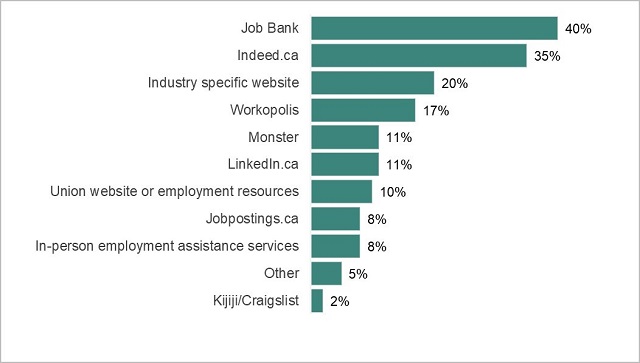
Text version of figure 3
| Job Board | Share of job seekers |
|---|---|
| Kijiji/Craigslist | 2% |
| Other | 5% |
| In-person employment assistance services | 8% |
| Jobpostings.ca | 8% |
| Union website or employment resources | 10% |
| LinkedIn.ca | 11% |
| Monster | 11% |
| Workopolis | 17% |
| Industry specific websites | 20% |
| Indeed.ca | 35% |
| Job Bank | 40% |
- Source: ESDC (2019). Annex B, internal source #1.
Compared to other Canadian job boards, Job Bank is a trusted platform with a secure and authenticated employer-employee matching process.
Job Matching services are now commonly offered by job boards. Artificial intelligence, machine learning, and algorithms support most job matching services. They vary from one platform to another with a fee structure ranging from between $150 to $1,800 per month (refer to Annex B internal source #1).
Social media platforms such as Facebook and LinkedIn collect information on their users’ skills, experience, education, interests, networks, and preferences. This allows employers to connect with job seekers without waiting for job seekers to apply. These platforms recruit highly qualified individuals who may not be actively looking for work.
According to program officials, the Job Bank online platform is primarily designed to support Employment Insurance policies and labour market objectives.
For a fee, private sector job boards allow employers to perform customized searches by limiting matches to the highest quality and specific industries. Private sector job boards provide ‘free text’ for employers to describe their needs.
| Features | Job Bank | Indeed | Jobillico | Monster | ||
|---|---|---|---|---|---|---|
| Use of cookies | No | Yes | Yes | Yes | Yes | Yes |
| In-app messaging | No | Yes | Yes | Yes | Yes | Yes |
| In-app videoconferencing | No | No | No | Yes | No | No |
| Bilingual postings and platform | Yes | No | No | No | No | No |
| Use of fixed occupation categories | Yes | No | No | No | No | No |
| Use of fixed skills categories | Yes | No | No | No | No | No |
| Use of fixed job description | Yes | No | No | No | No | No |
| Enhanced screening to allow employers to filter out unqualified candidates | No | Yes | Yes | Yes | Yes | Yes |
| Validate / authenticate employers and job postings using SIN and CRA business number | Yes | No | No | No | No | No |
| Mandatory provision of salary / wage information | Yes | No | No | No | No | No |
- Source: ESDC (2019). Annex B, internal source #1
General features of the Job Bank online platform relative to other job boards
Job Bank operates in a highly dynamic and innovative sector. While complementing services for employers and job seekers alongside private sector platforms, Job Bank offers a free and objective alternative. In particular, the Job Match service does not prioritize job postings to generate advertising revenue, and provides equal access to job seeker services without service or subscription fees. Relative to other job boards:
- Job Bank is the only bilingual platform and requires salary or wage information
- without the ability to use cookies, Job Bank is limiting the sharing of information about job seekers with third parties
- Indeed, Facebook, Monster, and Jobillico allow employers to use free text to list skills, job description and positions title. Job Bank and LinkedIn do not use free text
- Job Bank uses fixed skills, job descriptions, and occupation categories based on the National Occupation Codes
- Indeed, LinkedIn, Facebook, Jobillico, and Monster allow employers and job seekers to communicate with each other at any time through their platform via instant messaging or emails
- Facebook offers the additional option of videoconferencing
- employers with Job Bank can invite matched job seekers to apply but cannot otherwise communicate with potential applicants until they apply or respond to their invitation
- job seekers who sign up for the Job Match service must provide their SIN to ensure citizenship or approved status as Express Entry candidates
Between December 2018 and April 2019, over 70% or about 730 employers who provided voluntary responses to the Job Bank for Employer Survey indicated that their experience was:
- excellent (22%)
- good (31%)
- satisfactory (23%)
Why are Employers using Job Bank
Of those 41 employers with a Job Bank account who were interviewed as part of this evaluation, the top 3 reasons were:
- the service was free (70%)
- it attracts a large number of applicants (63%)
- it is convenient and easy to use (51%)
Evaluation approach
For the purpose of this evaluation report, 6 evaluation questions were identified to be answered:
- what are the characteristics of employers who use Job Bank for Employers?
- what are the socio-demographic characteristics of the job seekers who use Job Match?
- how effective has Job Bank been in matching job seekers and employers through Job Match?
- has the use of Job Match contributed to make the job search more effective for job seekers?
- has the use of Job Match contributed to make the recruitment process more effective for employers?
- to what extent have employers been able to hire workers, and job seekers find employment through Job Match?
- to what extent has the Job Match had an impact on labour market outcomes?
- what is the Job Match value added: compared to other Job Bank services? Compared to other Canadian job boards?
Evaluation scope
The focus of this evaluation is on job seekers, EI claimants and employers who used Job Bank products and services in 2017 and 2018.
- Express entry candidates are not part of this evaluation as they fall under the responsibility of Immigration, Refugees, and Citizenship Canada (IRCC)
- The Temporary Foreign Workers Program is subject to its own evaluation. Therefore, this evaluation excludes employers who used the Job Match Service to seek Temporary Foreign Workers
Annex C describes all lines of evidence as well as their respective timeframe.
Data Limitations
This evaluation excludes employers who used Job Bank services for the purpose of the Temporary Foreign Worker Program (TFWP) from 2 administrative databanks. Due to some discrepancies in the approach to select these employers within each databank, some TFWP employers were more than likely inadvertently included. Additional information can be found in Annex B, internal source #4.
The report uses data from the Job Bank program to focus on Job Match users in 2017 and 2018. Employers and job seekers are asked to inform program officials through a voluntary survey when hiring effectively took place as a result of using services from Job Bank. However, no information is being collected systematically. When information is provided by job seekers and employers, information is limited. As a result, the analysis of Job Match users and their labour market outcomes was not possible.
- One way to look at labour market outcomes of Job Match users would be to link Canada Revenue Agency (CRA) tax files with Job Match users’ information found in the program databank. At the time of the evaluation, tax files for 2018 were not available, preventing further analysis that may shed light on Job Match users’ labour market outcomes
- In addition, Job Match users may rely on several job boards to find work and not just rely on services available on the Job Bank platform. Other job boards include Indeed, LinkedIn, Jobillico, Facebook or Monster. As such, it is not possible to solely attribute outcomes to the Job Match service
Feedback provided on a voluntary basis by employers and Job Match users are captured by 2 surveys:
- the Job Match Deactivation survey, and
- the Job Match Posting Closeout Survey
Survey results were used to provide context on recruitment and job search patterns.
Employers are given the opportunity in the surveys to indicate if they hired job seekers from the following groups: Indigenous, visible minority, person with disabilities, youth, newcomers or older workers. A job seeker may belong to more than 1 group. Between December 2018 and April 2019, employers were able to provide information for about 2,780 jobseekers. Among those job seekers, it is unclear who were using the Job Match Service.
This evaluation used data from the Appliweb or the online application for Employment Insurance (EI) benefits to identify claimants who were also Job Match users. Several socio-economic variables from the EI administrative databank were extracted with claimants’ characteristics to better understand their speed in returning to work. Additional information can be found in Annex B, internal source #3.
Key findings
Finding #1
Job seekers have positive views on the value-added of the Job Match service with 60% of users recommending it to others. On the other hand, employers and partners views were more critical.
Feedback from an exit survey indicated that 60% or close to 4,930 job seekers would recommend the Job Match service to other users. This suggests that from a job seeker’s perspective, receiving feedback on potential job matches and their quality can play a role in informing and supporting their job search. As shown in Figure 4, a higher number of matches per job posting, and a higher proportion of jobs with quality matches (Figure 6) could support the fact that job seekers are recommending Job Match to others. However, no direct link can be drawn from the data. In 2017 and 2018, every job posted generated an average of 134 matches.
In 2017 and 2018, employers with a Job Bank For Employer (JBFE) account posted over 400,000 opportunities on the Job Bank online platform. Partners and employers interviewed as part of this evaluation were more critical of the value-added of the Job Match service.
- None of the provinces and territories are offering a matching service that is comparable to Job Match. However 3 out of 9 jurisdictions noted that the service had value added while the remaining thought that this service should be improved
- Of the 23 employers who used the Job Match service, 18 did not find it useful. Among those who provided reasons, 9 found the match quality to be poor
During interviews with program officials, officials recognized that the Job Match service did not work very well in the first 2 years or in 2015 and 2016. To their knowledge, relatively few employers are using it and the site usability has been better for job seekers than for employers.
The launch of employer-employee matching was a 3-phased process – registration, profile development and job matching. Modules were gradually released and tested for stability before releasing it to users (refer to Annex D for the Job Bank Enhancements Timeline, 2014 to 2018). The roll-out plan was more focused on job seekers’ interface.
“Currently, out of 184 matches, the highest match is 3 stars. That match has the education and is willing to relocate but doesn’t have any related experience. The second highest match is only matched on education, because he has a high school education.”(Employer using Job Bank)
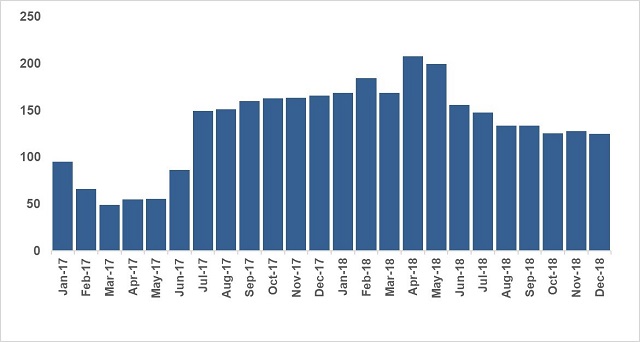
Text version of figure 4
| Posting period | Average number of matches |
|---|---|
| January 2017 | 95.3 |
| February 2017 | 66.0 |
| March 2017 | 48.9 |
| April 2017 | 55.1 |
| May 2017 | 55.5 |
| June 2017 | 86.7 |
| July 2017 | 149.3 |
| August 2017 | 151.1 |
| September 2017 | 159.8 |
| October 2017 | 162.6 |
| November 2017 | 163.5 |
| December 2017 | 166.0 |
| January 2018 | 168.9 |
| February 2018 | 184.2 |
| March 2018 | 168.7 |
| April 2018 | 207.9 |
| May 2018 | 199.5 |
| June 2018 | 155.8 |
| July 2018 | 147.7 |
| August 2018 | 133.9 |
| September 2018 | 133.4 |
| October 2018 | 125.4 |
| November 2018 | 128.0 |
| December 2018 | 124.8 |
- Source: ESDC (2020). Annex B, internal source #4
Awareness of the Job Match service amongst employers
Though employers have posted over 400,000 job opportunities on the Job Bank platform, feedback from the interviews indicated a low level of awareness of the Job Match service amongst employers. Of employers interviewed for this evaluation, 24% (11 out of 41) indicated that they did not use or did not know about the Job Match service. This proportion was 60% for employers who voluntarily responded to an exit survey (615 out of 1,025).
Employers interviewed were more inclined to use the Job Match service when they struggle to fill positions that normally require more experience, specialized skills and education. When seeking to fill low skilled positions with less training and education, employers reported that they received many résumés and did not need to engage in more active recruiting.
Employers interviewed generally used the Job Match service only after receiving and reviewing résumés and determining that the number/quality of résumés is insufficient.
Recent improvements of the Job Match service allow job seekers to receive email notifications when their profiles are matched to job vacancies. However, employers are required to access their Job Bank account to review the profiles of job seekers who have been matched to their job vacancies. At the time of the evaluation, no automatic notifications exist for employers.
In Figure 5, 18 out of 41 employers never reviewed job seekers profiles with matches. Among the 24 employers interviewed who provided suggestions for improvement, 6 indicated that sending emails would ensure that employers are made aware of the matches. The email alert could help employers to cut back on their recruitment efforts instead of having to log into their Job Bank account.
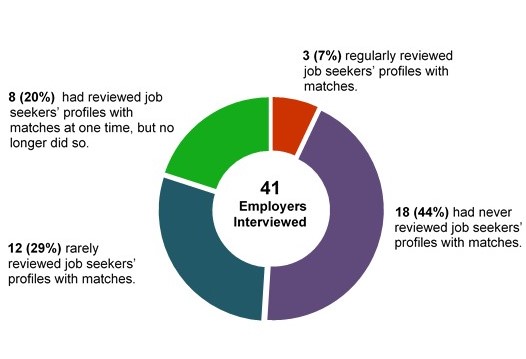
Text version of figure 5
| How often employers reviewed job seekers profiles | Share of Employers |
|---|---|
| Regularly reviewed job seekers’ profiles with matches | 7% |
| Had never reviewed job seekers’ profiles with matches | 44% |
| Rarely reviewed job seekers’ profiles with matches. | 29% |
| Had reviewed job seekers’ profiles with matches at one time, but no longer did so | 20% |
- Source: ESDC (2019). Annex B, internal source #2.
Finding #2
The effectiveness of the Job Match service is dependent on the completeness of information provided by job seekers. In addition, Job Match is limited by its heavy reliance on the National Occupational Classification system, which was not designed to support sophisticated matching algorithms.
Program’s partners and employers credited the Job Bank online platform during the interviews for its popularity and for providing good quality postings from a broad variety of industries.
Figure 6 shows the proportion of matches with a score of 3 or more, increasing to 14% in 2018 from about 2% in late 2017.
Ongoing refinements to the job matching algorithm, including adjustments made to reflect users’ behaviors contributed, in part, to this increase. For example, acceptance or rejection of previous job matches.

Text version of figure 6
| Posting period | Proportion of job postings |
|---|---|
| January 2017 | 0% |
| February 2017 | 0% |
| March 2017 | 1% |
| April 2017 | 1% |
| May 2017 | 2% |
| June 2017 | 2% |
| July 2017 | 2% |
| August 2017 | 1% |
| September 2017 | 2% |
| October 2017 | 1% |
| November 2017 | 2% |
| December 2017 | 2% |
| January2018 | 2% |
| February 2018 | 2% |
| March 2018 | 4% |
| April 2018 | 14% |
| May 2018 | 13% |
| June 2018 | 13% |
| July 2018 | 13% |
| August 2018 | 14% |
| September 2018 | 14% |
| October 2018 | 12% |
| November 2018 | 12% |
| December 2018 | 12% |
- Source: ESDC (2020). Annex B, internal source #4
A higher proportion of occupations with a score of 3 or more was observed among job seekers with a university degree. This could be partially explained by job titles tending to be more similar to the names of their fields of study. The reverse situation also applies. Without Job Match users’ experience, education, skill level, the probability for employers to invite them to apply decreased slightly, particularly for occupations with college or apprenticeship training.
According to Figure 7, about 1-in-7 (about 15%) Job Match users did not provide their level of education or credentials, thereby potentially impeding the effectiveness of the matching algorithm.
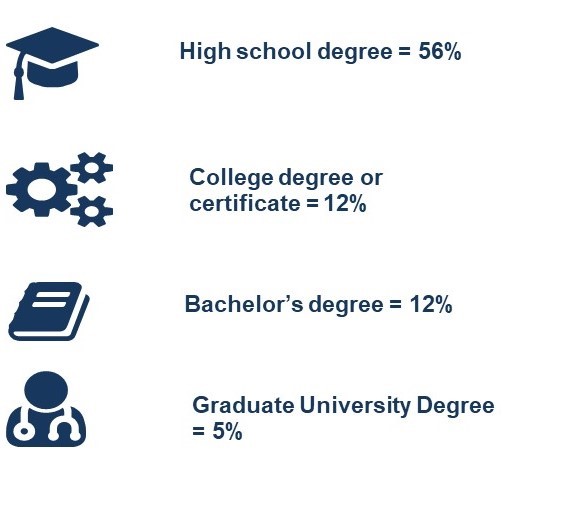
Text version of figure 7
| Highest level of education | Share of Job Match users |
|---|---|
| High school degree | 56% |
| College degree or certificate | 12% |
| Bachelor's degree | 12% |
| Graduate University Degree | 5% |
- Source: ESDC (2020). Annex B, internal source #4
The ability of employers to properly select the NOC or job titles for their advertised positions somewhat limits the effectiveness of the Job Match service. In Figure 8, about 63% of employers interviewed (26 of 41) were more critical of NOCs than employers surveyed, with 10 of them asking for the ability to make job titles more specific to their posting. Although not directly related to the selection of NOCs or job titles, 770 employers (or 77%) who voluntarily responded to the survey indicated that they found all necessary skills and job requirements when posting a vacant position on Job Bank.
While the NOC limits the flexibility of employers in choosing a job title, it does provide for a standardized approach and thereby easier to use in the job match algorithm.
Interviewees perceived the NOC to be too generic and believe that applicants can easily misunderstand their job requirements. Without the ability to use free text in favor of the NOCs, employers were unable to provide additional information about their job vacancies. Program officials are aware that lower skilled jobs have more generic NOC titles.
For example, 1 employer mentioned that the NOC for “dishwasher” is “pot washer”. Other limitations included: the requirement to indicate the average salary, requisite experience and education based on the NOCs do not always reflect industry standards or capture the diversity within industries.
According to the literature review for this evaluation, employers with an urgency to fill job vacancies had the tendency to post fewer job requirements. In these situation, employers included more information about the job application process. They were also quicker to remove their posters from a job board
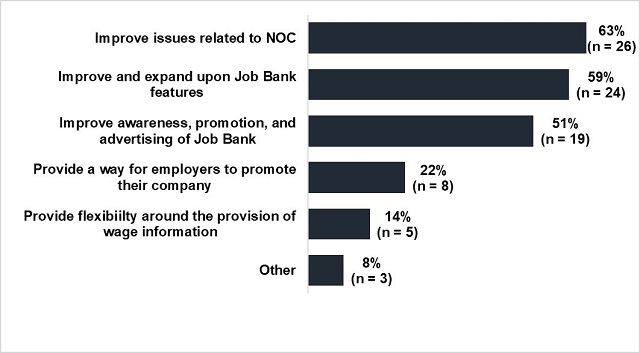
Text version of figure 8
| Suggestions for improvement | Number of employers | Share of employers |
|---|---|---|
| Improve issues related to NOC | 26 | 63% |
| Improve and expand upon Job Bank features | 24 | 59% |
| Improve awareness, promotion, and advertising of Job Bank | 19 | 51% |
| Provide a way for employers to promote their company | 8 | 22% |
| Provide flexibility around the provision of wage information | 5 | 14% |
| Other | 3 | 8% |
- Source: ESDC (2019). Annex B, internal source #1.
National Occupational Classification:
The National Occupational Classification is the product of a partnership between Statistics Canada and Employment and Social Development Canada. It is the nationally accepted taxonomy and organizational framework of occupations in the Canadian labour market.
Profile of Job Match users
Canadian job seekers can create a profile and register for the Job Match service without a fee. In 2017, over 84,600 were active users and in 2018, the number reached close to 124,340. Between these 2 periods, about 57,000 were new or first time subscribers to the Job Match service.
Among active Job Match users, about 1-in-10 was younger than 25. The share by age groups in Figure 9 was relatively similar and comparable to the Canadian labour force for the age groups of 25 to 55. Job Match users with a high school degree or no degree (56%) were over-represented compared to less than 35% in the Canadian labour force.
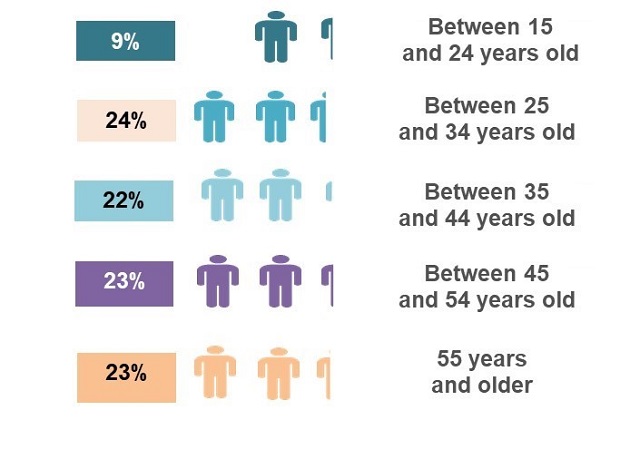
Text version of figure 9
| Age group | Share of Job Match users |
|---|---|
| Between 15 and 24 years old | 9% |
| Between 25 and 34 years old | 24% |
| Between 35 and 44 years old | 22% |
| Between 45 and 54 years old | 23% |
| 55 years and older | 23% |
- Source: ESDC (2019). Annex B, internal source #4.
Figure 10 points to a misalignment between the distribution of occupations sought by Job Match users and those sought by employers via their job vacancies. Observed differences were the largest for sales and service, trades, transport and equipment operators and business, finance and administration occupations.
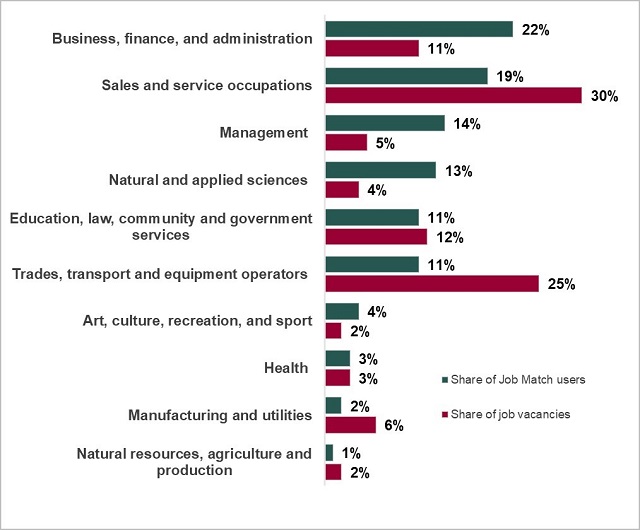
Text version of figure 10
| Occupational groups | Share of Job Match users | Share of job vacancies |
|---|---|---|
| Business, finance, and administration | 22% | 11% |
| Sales and service occupations | 19% | 30% |
| Management | 14% | 5% |
| Natural and applied sciences | 13% | 4% |
| Education, law, community and government services | 11% | 12% |
| Trades, transport and equipment operators | 11% | 25% |
| Art, culture, recreation, and sport | 4% | 2% |
| Health | 3% | 3% |
| Manufacturing and utilities | 2% | 6% |
| Natural resources, agriculture and production | 1% | 2% |
- Source: ESDC (2020). Annex B, internal source #4
Job Match service only takes into account job postings submitted by employers who are registered with Job Bank.
According to Figure 2, about 1-in-5 job vacancies were submitted by employers registered with Job Bank. For Job Match users to increase their opportunities to find work, they can also subscribe to the Job Alerts service to receive notifications for job opportunities.
Figure 11 shows the 3 provinces that maintain their own job boards and work directly with local employers. These include British Columbia (BC), Saskatchewan (SK) and Québec (QC).
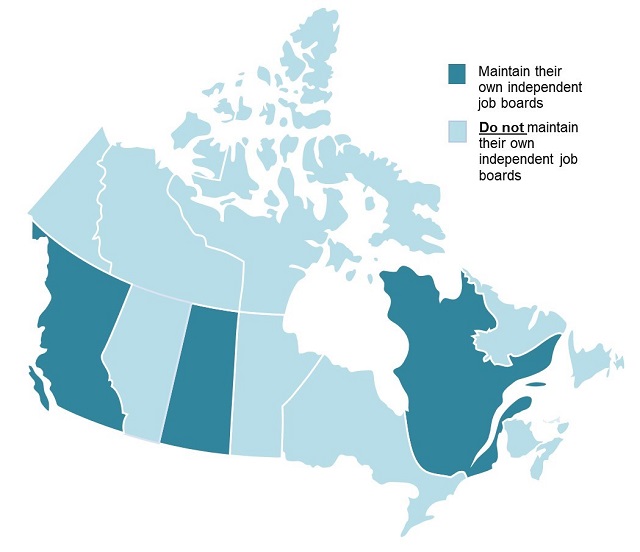
Text version of figure 11
| Province | Maintain their own independent job boards |
|---|---|
| Prince Edward Island | No |
| Nova Scotia | No |
| New Brunswick | No |
| Newfoundland and Labrador | No |
| Quebec | Yes |
| Ontario | No |
| Manitoba | No |
| Saskatchewan | Yes |
| Alberta | No |
| British Columbia | Yes |
| Territories | No |
- Source: ESDC (2019). Annex B, internal source #1.
Though job vacancies posted on independent job boards (BC, SK and QC) do appear on the Job Bank online, Job Match users are unable to view or access them. Employers using independent job boards would need to have 2 accounts at the provincial level and with Job Bank.
Figure 12 shows a misalignment between the distribution of Job Match users and job postings across provinces, particularly for BC, AB and QC.
- Misalignment is explained in part by the preference of employers in BC and QC for using their own provincial job boards. While these job posting can be viewed on Job Bank, the Job Match service does not account for them when looking for potential job matches
- For AB, a misalignment is due, in part, by a small drop in active employers (0.5%) using Job Bank services coupled with an increase of over 5,000 new Job Mach users
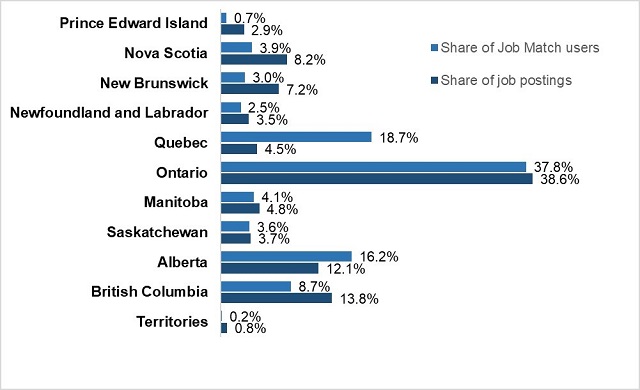
Text version of figure 12
| Province | Share of Job Match users | Share of job postings |
|---|---|---|
| Prince Edward Island | 0.7% | 2.9% |
| Nova Scotia | 3.9% | 8.2% |
| New Brunswick | 3.0% | 7.2% |
| Newfoundland and Labrador | 2.5% | 3.5% |
| Quebec | 18.7% | 4.5% |
| Ontario | 37.8% | 38.6% |
| Manitoba | 4.1% | 4.8% |
| Saskatchewan | 3.6% | 3.7% |
| Alberta | 16.2% | 12.1% |
| British Columbia | 8.7% | 13.8% |
| Territories | 0.2% | 0.8% |
- Source: ESDC (2020). Annex B, internal source #4
Profile of employers
Between 2017 and 2018, the number of active employers with Job Bank increased by 20%, from about 35,000 to close to 42,000.
- The majority of employers were small businesses with up to 99 employees
- Figure 13 shows an increase in the share of employers with up to 4 employees between 2017 and 2018. Nevertheless, it remains relatively small compared to the broader Canadian labour market where over 50% of small businesses employed up to 4 employees
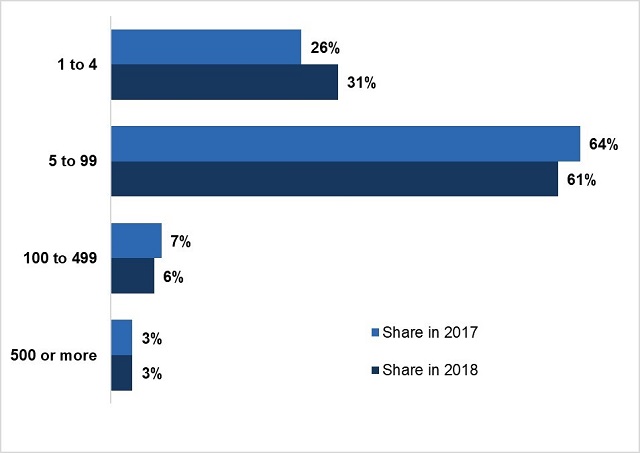
Text version of figure 13
| Employer size | Share in 2017 | Share in 2018 |
|---|---|---|
| 1 to 4 | 26% | 31% |
| 5 to 99 | 64% | 61% |
| 100 to 499 | 7% | 6% |
| 500 or more | 3% | 3% |
- Source: ESDC (2020). Annex B, internal source #4
As shown in Table 2, just over half of employers were from Ontario and BC in 2017 and 2018. During this period, however, their respective share displayed the largest variation.
- The decrease in Ontario has been offset by a significant increase in the share of employers in BC with an additional 4,000 employers. This resulted in a net loss of roughly 500 employers
- Accommodation and food services, construction and manufacturing sectors account for almost half of employers who posted job vacancies
| Province or Territories | Share in 2017 | Share in 2018 | Percentage change |
|---|---|---|---|
| Prince Edward Island | 2.2% | 1.8% | -0.3 |
| Nova Scotia | 6.5% | 5.3% | -1.2 |
| New Brunswick | 5.3% | 4.2% | -1.1 |
| Newfoundland and Labrador | 4.0% | 2.9% | -1.1 |
| Quebec | 5.9% | 7.0% | 1.2 |
| Ontario | 44.8% | 36.3% | -8.4 |
| Manitoba | 4.2% | 3.6% | -0.5 |
| Saskatchewan | 0.7% | 4.7% | 4.0 |
| Alberta | 14.4% | 14.0% | -0.5 |
| British Columbia | 11.3% | 19.3% | 8.0 |
| Territories | 0.8% | 0.7% | -0.1 |
| Total | 100% | 100 % | -3.2 |
- Source: ESDC (2020). Annex B, internal source #4
Finding #3
Job Match users are more likely to view a job posting when the matching score is high. However, other factors besides the match score influence employers following up with job seekers
Table 3 shows that 57% of Job Match users viewed job opportunities when a matching score was 4 (out of a maximum of 5). In contrast, 37% of users viewed a job posting when the score was 1. However, due to data limitations, the evaluation was not able to conduct a probabilistic analysis examining factors affecting the viewing of a job match.
| Average match score (maximum 5) | Share of Job Match users |
|---|---|
| 4.0 | 57% |
| 3.5 | 50% |
| 3.0 | 43% |
| 2.5 | 51% |
| 2.0 | 55% |
| 1.5 | 50% |
| 1.0 | 37% |
- Source: ESDC (2020). Annex B, internal source #4
Results from a probabilistic regression found no relationship between the matching score from 1 to 5 and the likelihood of a job seeker to be invited to apply for vacant positions. Factors in Table 4 show that the Job Match service appears to be suited for specific size and type of businesses.
Table 4: Factors affecting the probability for employers to invite job seekers
For accessibility reasons, the information is presented in text format. Consult the PDF version for the table.
Higher probability is associated with:
- business with up to 4 employees ***
- longer posting duration (0.023)***
- job opportunities belonging to the Trades, Transport and Equipment Operator categories (0.005)*** compared to Sales and Service occupations as the reference group
- occupations requiring college education or apprenticeship training (0.006)*** compared to those that required secondary school and/or specialized occupations as the reference group
- postings from British Columbia (0.047)***, Quebec (0.015)*** or Manitoba (0.006) relative to postings in Ontario as the reference province
Lower probability is associated with:
- businesses with 5 to 99 employees (-0.12)***; medium sized with 100 to 499 employees (-0.015)*** and large employers with more than 500 employees (-0.02)***
- job opportunities belonging to the Natural and Applied Sciences groups (-0.013)***, or, the Business, Finance, and Administration groups (-0.011)***, or, occupations belonging to the Art, Culture, Recreation, and sport (-0.012)*** compared to Sales and Service occupations as the reference group
- occupations requiring on the job training(-0.006)*** ,or, a university degree (-0.008)** compared to occupations that required secondary school and/or specialized occupations as the reference group
- Source: ESDC (2020). Annex B, internal source #4. ** indicates statistical significance at the 5% level, and *** at the 1% level.
Job Match service had minimal impact on employers’ recruitment time
In 2018, an average of 16% of jobs posted with a match led employers to invite candidates to apply if their search lasted more than 30 days compared to an average of 6% in the previous year. This increase is explained by the fact that since August 2017, employers who use the Job Bank online platform services to hire workers from the Temporary Foreign Worker Program (TFWP), are required to post for 30 days or more. They are also expected to invite Canadian job seekers to apply when a matching score was 2 or more.
This evaluation does not cover TFWP employers. As such, hiring patterns of employers who posted job vacancies under 30 days are further examined.
Table 5 shows an average of over 26 invitations were sent by employers looking to fill vacancies in the Management, and Sales and Services occupational groups.
- For the Management group, employers were more likely to provide additional information about the job requirements. In addition, job seekers looking for a management position were likely to submit a complete profile, leading to higher match quality
- For the Sales and Services group, employers may have had access to a larger share of job seekers looking for jobs in this sector
| Occupational groups | Average number of invitations |
|---|---|
| Management | 26.4 |
| Business, finance, and administration | 15.6 |
| Natural and applied sciences | 7.0 |
| Health occupations | 9.5 |
| Education, law and social, community and government services | 13.6 |
| Art, culture, recreation, and sport | 10.4 |
| Sales and services | 26.8 |
| Trades, transport and equipment operators | 10.5 |
| Natural resources, agriculture and related production | 13.8 |
| Occupations in manufacturing and utilities | 14.0 |
| Overall | 16.8 |
- Source: ESDC (2020). Annex B, internal source #4
Currently the program does not track whether an individual was hired following a job match and an invitation from an employer. Of employers who have hired someone, 44% or about 4,280 associated their hiring as a result of advertising on the Job Bank online platform.
About 34% or 3,300 employers were able to hire someone within 2 weeks or up to 14 days. According to Job Bank partners and a hand full of employers interviewed, this proportion is likely to be lower for job vacancies in rural, remote areas, parts of western provinces and Québec.
Employers interviewed (16 of 41) mentioned that Job Bank services had a minimal impact on their recruitment time. The literature indicates that for some employers in Finland, the probability of filling a vacancy was 14% higher when using online job boards.
Profile of Employment Insurance claimants in receipt of regular benefits and Job Match users
With a view to examine the extent to which the Job Match service may help job seekers to find work, the evaluation analyzed a subset of Job Match users who were in receipt of regular EI benefits. In particular, the analysis looks into whether EI claimants who subscribe to the Job Match service tend to return to work sooner relative to those who did not subscribe to the Job Match service.
In 2017, out of the 1.1 million claimants who received only regular benefits, a little over 2% or 22,725 were Job Match users (refer to Annex B, internal source #3).
Compared to claimants of regular benefits, EI – Job Match users were:
- predominantly men
- older than 45 years of age (55% vs 47%)
- residents of Alberta, Saskatchewan, Manitoba and Ontario
- graduates from a college or university (64% vs 45%)
- entitled to more weeks of regular benefits
- received, on average, almost 2.4 weeks more of benefits
Key results from a recent evaluation of the Connecting Canadians with Available Jobs initiative indicate that “early information provision could potentially be an effective policy for reducing EI benefits paid when targeted at specific subgroups” (refer to Annex B, external source #2).
With a statistical matching method known as the Coarsened Exact Matching (CEM), a comparison group was created to represent claimants with characteristics that were similar to claimants who did not use the Job Match service. The sample of claimants who used the service included about 6,640 individuals.
Furthermore, this evaluation examines behaviors of claimants based on the timing of their subscription to the Job Match service.
Comparison group to claimants with regular benefits
To create a representative comparison group for EI claimants who used the Job Match service, the CEM was used as a matching technique. It selects similar groups of non-users based on age, gender, province of residence, educational level, and occupation.
For additional information, refer to Annex B, internal source #3.
Finding #4
Overall, results indicate that the job match service has a limited effect on the exhaustion of Employment Insurance regular benefits.
Employment Insurance claimants are said to have exhausted their regular entitlement when the number of weeks of benefits received (actual duration) equals the full entitlement available over the course of the benefit period.
By comparing claimants who never used the Job Match service during their entitlement period, a probabilistic regression shows that overall Job Match users were on average 2.9% more likely to exhaust their benefits (refer to Figure 14).
Further dividing users by the timing of their service activations, ‘Early users’ were found less likely to exhaust their benefits. ‘Midway users’ and ‘Late users’ were both more likely to exhaust their benefits. In particular, Early users were 3.0% less likely to exhaust their benefits.
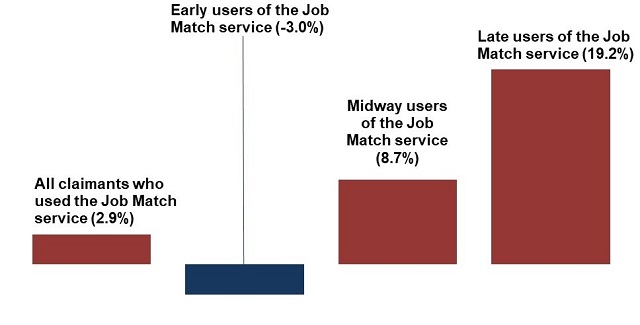
Text version of figure 14
| User type | All claimants who used the Job Match service | Early users of the Job Match service | Midway users of the Job Match service | Late users of the Job Match service |
|---|---|---|---|---|
| Probability | 2.9% | -3.0% | 8.7% | 19.2% |
- Source: ESDC (2019). Annex B, internal source #3
For the purposes of the analysis, claimants in receipt of regular benefits and who subscribe to the Job Match service are broken down into 3 groups:
- early users: Activate Job Match account in the first third of their benefit period
- midway users: Activate Job Match account in the second third of their benefit period
- late users: Activate their Job Match account in the last third of their benefit period
The results associated with the classification of users according to their timing of service activation should be interpreted with caution. For instance, more motivated claimants may ‘self-select’ themselves early into the service as a result of their more proactive job search strategy. In fact, Table 6 outlines other factors that affected the probability of exhausting regular benefits, such as age, occupational groups and province of residence.
Looking only to those claimants who exhausted their Employment Insurance regular benefits, does not provide a complete picture, since a number of claimants find work and end their claim prior to exhausting their regular entitlements. To address this shortcoming, the evaluation further examines whether using job match service may contribute to a lower probability to claim an additional week of regular benefits throughout one’s claim, via the conduct of a survival analysis using the Extended Cox Proportional Hazard model. For the purposes of this analysis, 2 aspects associated with the usage of the Job Match service are accounted for at any point in time throughout the examined claims:
- the total number of job matches received by a user
- the average matching scores of these job matches
Results found are consistent across the 3 groups of EI claimants who use the Job Match service (early, mid-way and late users).
Table 6: Factors affecting the probability of exhausting regular benefits
For accessibility reasons, the information is presented in text format. Consult the PDF version for the table.
Those with a decreased probability:
- early users of the Job Match service (-3%) *** compared to non-users of the Job Match service
- claimants younger than 25 years of age (-7%)*** compared to those aged 35 to 44
- residents in Quebec (-4%)** or British Columbia compared to residents in Ontario
- education, Law, and Social, Community and Government occupations (-12%)*** and Trades, Transport and Equipment operators (-13%) compared to Sales and Service occupations
Those with an increased probability:
- mid way users (+8.7%)*** and Late users (19.2%)*** compared to non-users of the Job Match service
- female claimants (2%)** compared to male claimants
- claimants between the ages of 55 and 64 (+13%)*** and 65 years and older (27%)*** compared to those aged 35 to 44
- residents in Alberta, Saskatchewan or Manitoba (+3%)*** compared to residents in Ontario
- claimants belonging to the Health occupational group (12%)** compared to the Sales and Service occupations
- Source: ESDC (2020). Annex B, internal source #4. ** Indicates statistical significance at the 5% level, and *** at the 1% level.
Finding #5
Employment Insurance claimants who use Job Match and had higher than average job matching scores were more likely to return to work rapidly. However, there is insufficient evidence to attribute this outcome to the Job match service alone.
For all 3 groups (early, mid-way and late users), the accumulated number of job matches did not have an influence over the probability to claim an addition week of EI benefits.
However, for all 3 groups, an increase in the average matching score was associated with a decreased probability to claim an additional week of Employment Insurance benefits.
Compared to the other 2 groups, Early users were somewhat more sensitive to changes in the average matching score (indicated by the higher slope of the curve in Figure 15). This suggests that Early users may be more selective about the suitability of available jobs.
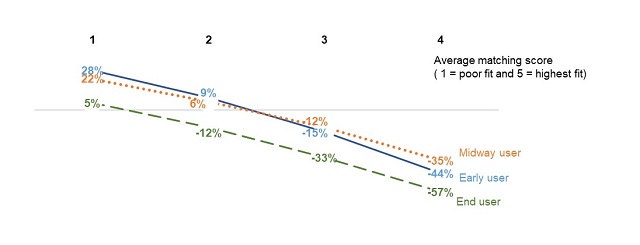
Text version of figure 15
| User status | Match score | Probability |
|---|---|---|
| Early users | 1 | 28% |
| Early users | 2 | 9% |
| Early users | 3 | -15% |
| Early users | 4 | -44% |
| Midway users | 1 | 22% |
| Midway users | 2 | 6% |
| Midway users | 3 | -12% |
| Midway users | 4 | -35% |
| Late users | 1 | 5% |
| Late users | 2 | -12% |
| Late users | 3 | -33% |
| Late users | 4 | -57% |
- Source: ESDC (2019). Annex B, internal source #3.
These findings are consistent with the notion that key to finding a job is how one’s profile aligns with job opportunities, and not just the sheer number of available jobs. In fact, results suggests that Job Match Service can play a role in identifying these instances of ‘right fit’ for the job. However, there is insufficient evidence to attribute this outcome to the Job Match service alone.
- The share of Employment Insurance claimants who used Job Match is small with the risk of ‘self-selection’ biasing the results. From the close to 24,000 survey respondents who used the Job Match service and who voluntarily provided feedback, only 3,260 were receiving Employment Insurance benefits
- In addition, information on job search activities pursued by job seekers, other than subscribing to Job Match Service, was not available. The same applies to employers’ hiring processes and the potential role that the Job Match service may play in supporting them
Conclusion and recommendation
Since its inception, Job Bank has made significant efforts to better connect job seekers and employers through various services provided on their platform. This is captured in 3 recent reports (refer to Annex A). Job Bank typically has over 1.2 million job postings a year on their platform. For a portion of these jobs, the Job Match service provides an opportunity for job seekers and employers to connect.
The use of artificial intelligence (AI) and machine learning for the purposes of job matching is a rapidly evolving field. In fact, despite its young existence, the Job Match service has already been subject to a number of improvements since its introduction in 2015.
Overall, the report showed that a small, but growing number of job seekers and employers are using Job Match service for the purposes of finding jobs or to recruit potential candidates. Though Job Match users have positive views on the value-added of the service, views from employers were more critical. As the Job Match service matures with time, further improvements of the site usability should shift towards meeting the needs of employers.
Lastly, the evaluation examined whether Employment Insurance claimants who subscribe to the Job Match service tend to return to work sooner relative to those who did not subscribe to the Job Match service. Overall, results indicate that the effect of the job match service on the exhaustion of Employment Insurance regular benefits is limited. Still, claimants who use Job Match and had higher than average job matching scores were more likely to return to work rapidly. However, there is insufficient evidence to attribute this outcome to the Job Match service alone.
Based on these findings, the Evaluation Directorate offers the following recommendations:
- recommendation #1: Explore approaches to ensure job seekers provide more complete profile information to allow for the opportunity of better job matches with potential employers
- recommendation #2: Develop and pilot a promotional strategy for employers to improve the level of awareness of the Job Match service
- recommendation #3: Conduct needs assessment with selected employers to develop, pilot and implement features that enhance the Job Match experience for employers
Management response and action plan
Recommendation #1
Explore approaches to ensure job seekers provide more complete profile information to allow for the opportunity of better job matches with potential employers.
Management agrees.
Job Bank strives to enhance the experience of all users based on their evolving needs. Throughout 2019 and 2020, Job Bank continued to enhance user experience, particularly that of job seekers, by improving the Job Match profile creation process, and the matching algorithm. These features seek to tailor the application to the needs of both employers and job seekers.
In May 2019, Job Bank adapted the job seeker’s algorithm to better reflect the user’s desired career expectation and profile. Job seekers can select between an algorithm that values more education, experience or overall skills for a tailored approach to their job search. Job seekers can choose from the 3 algorithms to improve their job matches from potential employers. The custom algorithms aim to minimize the impact of an incomplete profile on the quality of the match. If the user doesn't enter any information in the education, experience or overall skills sections, the system will display a message informing them that the corresponding algorithm won't be available for their use.
To assist job seekers with creating a more complete profile, Job Bank has developed an ongoing process to add new job titles as suggested by users. Upon receiving the suggestion, Job Bank adds the titles to a proposed list to be inputted in the system so the user can select the one that best reflects their experience. In collaboration with the National Occupation Classification team, Job Bank established a procedure to add new job titles and skills in a timely manner, as well creating a job titles list as exhaustive and accurate as possible for the future.
Job Bank also enhanced the education section of the job seeker profile by extending the list of searchable programs from the Classification of Instructional Program (CIP). Prior to this change, some users had difficulties finding their specialized education program due to the limited program list in the search. This issue might have led some users to simply omit the information, which impacted the accuracy of their job matches. The introduction of the extended list of education programs allows job seekers to input their exact program name.
Job Bank also has plans to improve the current inventory of skills. By aligning with the recently introduced Skills and Competencies Taxonomy, Job Bank aims to provide a more extensive and structured list of skills to users for their profile creation. Job seekers will be able to refine their skills selection in the profile, thus receiving better job matches. In collaboration with other teams within the Labour Market Information Directorate, Job Bank will continue its efforts to expand and refine the skills inventory. The first stage was completed at the end of 2020, and the next steps of the skills inventory update will proceed throughout 2021 and 2022.
During the COVID-19 pandemic, Job Bank has served as a key resource for users to find employment opportunities. These enhancements will allow users to provide a detailed, and complete description of their education and work experiences in their profile. Such profiles lead to job matches of an improved quality, resulting in more efficient job search activities.
Actions planned
1.1 Update the inventory of skills to align with the Skills and Competency Taxonomy
Anticipated completion date
Winter 2022
Recommendation #2
Develop and pilot a promotional strategy for employers to improve the level of awareness of the Job Match service.
Management agrees.
A redesign of the employer dashboard is underway. The updated dashboard will enable employers to navigate Job Match results efficiently by displaying an overview of the matches received and the number of applicants interested in the job opportunity. The enhanced visibility and the accessibility of the feature is expected to increase employers’ awareness of Job Match services.
In addition, Job Bank is currently building a resume sharing tool, which is expected to launch in 2021. The service will allow Plus account job seekers to send their resumes directly to employers via the Job Bank platform. For ease of access, resume sharing, job matches and activity report will all be displayed in the same section. Traffic to the Resume Sharing tool is expected to draw more employers’ attention to the Job Match services.
Job Bank also plans to integrate a seamless email process in the Job Match service to alert employers of their matches. As a promotional strategy, an email will be sent, upon creation of a job posting, to notify employers of potential candidates and the features of Job Match. Job Bank may seek to expand this functionality and create a weekly email with the match results.
Actions planned
2.1 Redesign employer dashboard page that highlights Job Match to users through preview boxes
Anticipated completion date
Spring 2021
Actions planned
2.2 Build the Resume Sharing tool for job seekers and employers
Anticipated completion date
Spring 2021
Actions planned
2.3 Send emails of match results to employers upon creation of a job posting
Anticipated completion date
Fall 2021
In addition to raising awareness of employers with existing user accounts, Job Bank plans to invite new employers to the service. A series of online ad campaigns, via Social Media and banners, aim to attract new employers. The first campaign successfully rolled out in October and November 2020, bringing over 160,000 visits to Job Bank for Employers. A second campaign is underway starting in January 2021.
In parallel, Job Bank, jointly with the Canada Revenue Agency, has implemented messaging to promote its service to employers visiting the CRA’s Business Registration Online page. Currently employers visiting 2 of the CRA’s static webpages to register a business number can see the message; additional messaging is scheduled to be added upon the employers’ completion of their business registration process.
Finally, Job Bank will promote Job Match to employers who experience difficulty in finding employees by engaging directly with employer groups.
Actions planned
2.4 Implement messaging on the CRA’s business registration online
Anticipated completion date
Spring 2021
Actions planned
2.5 Engage with employer groups who may experience hiring difficulty
Anticipated completion date
Fall 2022
Recommendation #3
Conduct needs assessment with selected employers to develop, pilot and implement features that enhance the Job Match experience for employers.
Management agrees.
Job Bank has established multiple streams to collect feedback. All users can contact Job Bank through the website or via email, and provide their comments to improve our features. All comments are reviewed on a daily basis. To understand the needs of the users, Job Bank has also developed various surveys. Survey responses are regularly analyzed in order to gather the requirements for an effective job board service. Additionally, Job Bank has created 2 separate working groups (Job Match and User Experience) to develop innovative ideas, identify specific audiences, and accommodate their needs. The feedback obtained from all these sources informs Job Bank of the effectiveness and user experience of the respective services; it also supports Job Bank in making informed decisions.
In April 2020, Job Bank worked with ESDC’s Client Experience Group (CEG) to review the Job Bank for Employers application. The ensuing recommendations provided guidance for the employer dashboard redesign and highlighted areas for other improvements. Following the implementation of the employer dashboard, Job Bank will work again with the CEG to assess the improvements made regarding the employer’s user experience.
Actions planned
3.1 Conduct a 2nd user experience study focusing on the new employer dashboard and Job Match, in collaboration with the Client Experience Group
Anticipated completion date
Fall 2021
Annexes
Annex A: Summary of previous studies related to Job Bank
The Evaluation of the Labour Market Information component of the Job Bank completed in 2017 showed that:
- 70% of job seekers were satisfied with Job Bank
- 68% of employers with Job Bank accounts were satisfied with the website and services received
- 60% of employers used Job Bank as primary place to post job vacancies, and
- more than two third of job seekers were aware and used the information on career planning and labour market trends found it useful
The Evaluation of Connecting Canadians with Available Jobs Initiative completed in 2018 focused on enhancements to Job Alerts and labour market information and their effectiveness in supporting job-search activities. The Job Alerts service is an email notification service that informs subscribers about job openings advertised on the Job Bank website. This evaluation found that:
- the initiative was successful at improving the awareness of the existence of the Job Alerts service and the subscription to the service
- larger exposure to Job Alerts service was positively linked to the number of interviews and job offers, the number of hours of search in a typical week and the likelihood of switching from a temporary to a permanent job
The supplemental study on Trends in Employment Insurance (EI) Claimants’ Registration with Job Bank completed in 2020, examined the use of the Job Alerts service that is available to job seekers who applied for EI benefits online. Key findings included:
- the share of EI applicants, who subscribed to Job Alerts after receiving an invitation, steadily increased from about 20% in December 2017 to about 35% in April 2019. Subscribers were more likely to be women; 45 years or older; and to have graduated from college or university
- over half of job postings came from 2 occupational categories: Sales and Services and Business, Finance, and Administration related occupations
- close to half of job postings required a university degree or college diploma/apprenticeship training. About 37% required a high school diploma and/or job-specific training
- Prince Edward Island, Newfoundland and Labrador, Nova Scotia, New Brunswick were among provinces with the largest share of postings that required on-the-job-training
- the average hourly rate of pay of posted jobs increased from $16.50 in 2017 to $18.60 in 2019, for a percentage increase of 12.7%
- in 2018, the average duration of job postings was 36 days, relative to about 29 days in 2017
Annex B. Bibliography
Data Sources
S1. Job Bank Administrative Data
S2. Employment Insurance (EI) Administrative Data
S3. Job Match General Survey— January 2017 to December 2017
S4. Job Bank Deactivation Survey—April 2018 to April 2019
S5. Job Bank for Employers Survey—December 2018 to April 2019
S6. Job Posting Closeout Survey—December 2018 to April 2019
Internal Sources (not published, available upon request)
- Employment and Social Development Canada (2019). Literature Review for the Evaluation of Job Bank as an online platform delivering services to Canadians
- Employment and Social Development Canada (2019). Interviews with Employers, Provincial and Territorial Representatives, and Program Officials
- Employment and Social Development Canada (2019). The Impact of the Job Match Service on Employment Insurance Claimants—Regular Benefits
- Employment and Social Development Canada (2020). The Effectiveness of the Job Match Service for Employers and Job Seekers
- Employment and Social Development Canada (2019). Trends in EI Claimants’ Registration with Job Bank
- Employment and Social Development Canada (2018, last updated on January 6, 2018). Job Bank 2017 to 2018 Summary Report. Available upon request
External Sources
E1. Employment and Social Development Canada (2017). Evaluation of Learning and Labour Market Information as disseminated by Employment and Social Development Canada using a web-based consolidated approach
E2. Employment and Social Development Canada (2017). Evaluation of the Connecting Canadians with Available Jobs initiative
Annex C: Evaluation Approach
The evaluation looks at Canadian job seekers—including Employment Insurance (EI) claimants — employers, and provinces and territories who co-deliver this platform with the federal government. The focus of this evaluation is on the effectiveness of the Job Match service in matching job seekers with employers, and the impact of the Job Match service on the return to work for EI claimants who received the regular EI as the type benefit.
Quantitative lines of evidence were developed using the Job Bank program and the Appliweb which is an online application system for EI benefits. To examine claimants’ behaviors, data from the departmental Job Bank was linked to the EI Status Vector file (SV) administrative databanks. They were linked to produce information that was used to compare claimants and non-claimants.
- More specifically, only the 2017 cohort of claimants in receipt of regular benefits was used since significant changes were made to the Job Match algorithm in 2015 and 2016. This cohort included about 6,900 claimants (refer to Annex B, internal source #3)
- Where appropriate, these lines of evidence were enriched with other external sources of data and relevant literature to provide context to the analysis
Key Informant Interviews provided an important source qualitative evidence. Interviews with 41 employers who use Job Bank in 2018 and 2019, 10 provincial and territorial representatives who participate in the co-delivery of Job Bank services; and 5 Job Bank officials who work at ESDC in various areas related to the delivery of Job Bank — a total of 56 participants. Interviews were conducted in May and June 2019.
Annex D: Job Bank Enhancements Timeline (2014 to 2018)
2014
- December: Test of the Job Bank for Employers 2.0 (JBFE) and release of Job Match registration for job seekers
2015
- January: Launch of the IRCC’s Express Entry (EE) initiative: eligible EE candidates start registering in Job Match
- January : Test of JBFE 2.0 by a limited number of new employers; low-key release of the job seeker profile component
- February to March : Release of job seekers matching component: work to address bugs in the JBFE 2.0
- April: Release of the Job Match for employers; start of stabilization period for Job Match for seekers
- May to June: Stabilization period for JBFE 2.0
- November: Job seekers may choose between receiving broad or refined job matching results; further enhancements to matches based on credential, education and experience
2016
- August: 2-way communication between job seekers and employers is possible
- November: Labour mobility enhancements (job seekers may notify employers if they are willing to relocate for employment)
- November: Job seekers profiles provides descriptions for National Occupational Classification (NOC) work experience; presentation modified of met/unmet qualifications in Job Match
2017
- February: New landing page for employers, enhanced controls and views related to Job Match
- March: Job postings disseminated for less than 30 days are distinguished from jobs posted 31 days or more in the activity report; both categories are subdivided into Express Entry and Canadians users; matches to Canadian citizens are identified
- June: Job Match results can be filtered by employment groups
- As of June 6, Job Match registration becomes voluntary for EE candidates
- As of Aug, 27, employers who want to hire TFW must use Job Match. Prior to this, employers could use either Job Bank or provincial counterparts in British-Columbia, Saskatchewan and Quebec
2018
- February: Redesign of Job Match survey
- July: Redesign of location preferences for job seekers
